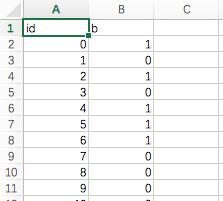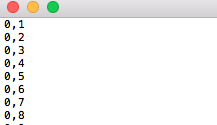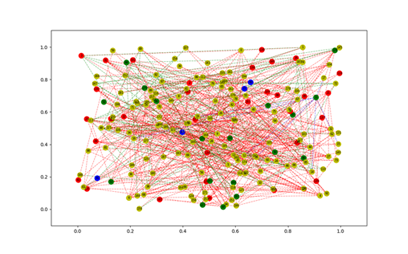前言
昨天才开始接触,鼓捣了一个下午,接下来会持续更新,如果哪里有错误的地方,望各位大佬指出,谢谢!
数据描述
两个文件,一个文件包含了网络图的节点,节点存在类别(0,1,2,3)四类,但是0类别舍去,不画出;另一个文件包含了网络图的边,数据基本特征如下:


图1中,id表示节点,b是类别;图2中,两个数字表示边连接的两个点。
Networkx
安装
我的系统是Mac OS,直接在terminal输入sudo pip install networkx就可以安装,由于代码中涉及几个函数,在python3中会报错,我用python2.7.13实现的
基本使用方法
import networkx as nx #导入networkx包
import matplotlib.pyplot as plt #导入绘图包matplotlib(需要安装,方法见第一篇笔记)
G =nx.random_graphs.barabasi_albert_graph(100,1) #生成一个BA无标度网络G
nx.draw(G) #绘制网络G
plt.savefig("ba.png") #输出方式1: 将图像存为一个png格式的图片文件
plt.show() #输出方式2: 在窗口中显示这幅图像参数介绍基本
- `node_size`: 指定节点的尺寸大小(默认是300,单位未知,就是上图中那么大的点) - `node_color`: 指定节点的颜色 (默认是红色,可以用字符串简单标识颜色,例如'r'为红色,'b'为绿色等,具体可查看手册) - `node_shape`: 节点的形状(默认是圆形,用字符串'o'标识,具体可查看手册) - `alpha`: 透明度 (默认是1.0,不透明,0为完全透明) - `width`: 边的宽度 (默认为1.0) - `edge_color`: 边的颜色(默认为黑色) - `style`: 边的样式(默认为实现,可选: solid|dashed|dotted,dashdot) - `with_labels`: 节点是否带标签(默认为True) - `font_size`: 节点标签字体大小 (默认为12) - `font_color`: 节点标签字体颜色(默认为黑色)
布局
- circular_layout:节点在一个圆环上均匀分布
- random_layout:节点随机分布
- shell_layout:节点在同心圆上分布
- spring_layout: 用Fruchterman-Reingold算法排列节点
- spectral_layout:根据图的拉普拉斯特征向量排列节点
代码
# coding:utf-8
import networkx as nx
import matplotlib.pyplot as plt
import csv
with open('node-8.csv','rb') as csvfile:
reader = csv.DictReader(csvfile)
column = [row['b'] for row in reader]
id_tag0 = [row['id'] for row in reader]
#print column
id_tag = []
for item in id_tag0:
id_tag.append(int(item))
# =================Setting node parameters====================
node_0 = []
node_1 = []
node_2 = []
node_3 = []
node_color = []
node_color_y = []
node_color_r = []
node_color_g = []
node_color_b = []
node_shape = []
node_shape_0 = []
node_shape_1 = []
node_shape_2 = []
node_shape_3 = []
for i in range(len(column)):
if int(column[i]) == 0:
pass
elif int(column[i]) == 1:
color = 'r'
shape = 'o'
node_1.append(i)
node_color_r.append(color)
node_shape_1.append(shape)
elif int(column[i]) == 2:
color = 'g'
shape = 'o'
node_2.append(i)
node_color_g.append(color)
node_shape_2.append(shape)
else:
color = 'b'
shape = '*'
node_3.append(i)
node_color_b.append(color)
node_shape_3.append(shape)
node_color.append(color)
node_shape.append(shape)
# ==============================================================
with open('node-8.csv','rb') as csvfile:
reader = csv.DictReader(csvfile)
column1 = [row['b'] for row in reader]
id_tag1 = [row['id'] for row in reader]
#print column
id_tag11 = []
for item in id_tag1:
id_tag11.append(int(item))
edge = []
with open('edge-8.txt','r') as f:
data = f.readlines()
for line in data:
#print line
line = tuple(line.replace('\r','').replace('\n','').replace('\t','').split(','))
edge.append(line)
#print edge
# ===============Setting edge parameters=========================
edge_color = []
edge_style = []
for item in edge:
#print item
if int(column1[int(item[0])]) == 0 or int(column1[int(item[1])]) == 0:
pass
elif int(column1[int(item[0])]) == 1 or int(column1[int(item[1])]) == 1:
color = 'r'
#style0 = 'dashdot'
#color_r_list.append(color)
elif int(column1[int(item[0])]) == 2 or int(column1[int(item[1])]) == 2:
color = 'g'
#style0 = 'dashed'
#color_r_list.append(color)
else:
color = 'b'
#style0 = 'dotted'
#color_b_list.append(color)
edge_color.append(color)
#edge_style.append(style0)
G = nx.Graph()
#G.add_nodes_from(id_tag)
G.add_edges_from(edge)
#nx.draw(G,pos=nx.random_layout(G), nodelist = node_0, node_color = node_color_y, node_size=120, node_shape=node_shape_0)
#nx.draw(G,pos=nx.random_layout(G), nodelist = node_1, node_color = node_color_r, node_size=120, node_shape=node_shape_1)
#nx.draw(G,pos=nx.random_layout(G), nodelist = node_2, node_color = node_color_g, node_size=120, node_shape=node_shape_2)
#nx.draw(G,pos=nx.random_layout(G), nodelist = node_3, node_color = node_color_b, node_size=120, node_shape=node_shape_3)
nx.draw_networkx(G,pos=nx.random_layout(G),node_color=node_color,node_size=10,node_shape='o',edge_color=edge_color,width=0.3,style='solid',font_size=8)
#nx.draw_networkx(G,pos=nx.random_layout(G),nodelist = node_1,node_color=node_color,node_size=100,node_shape='o',style='dashdot')
#nx.draw_networkx(G,pos=nx.random_layout(G),node_color=color_g_list,node_size=150,node_shape='^',style='dashed')
#nx.draw_networkx(G,pos=nx.random_layout(G),node_color=color_b_list,node_size=150,node_shape='*',style='dotted')
#plt.legend()
#nx.draw_networkx(G)
plt.show()画图

以上就是本文的全部内容,希望对大家的学习有所帮助,也希望大家多多支持脚本之家。